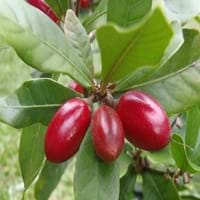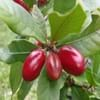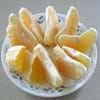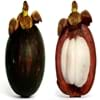Health Benefits
Good for diabetics, Improves well-being, Miraculin/miracle fruit makes sour things taste sweet
Anti-aging benefits, Boosts immune system, Cancer prevention, Flu treatment, Hair care, Heart care, Improves eye vision, Increases metabolic rate, Kidney stone treatment, Maintains healthy cholesterol level, Skin cleansing, Skin rejuvenation, Treatment of common cold, Treatment of skin Diseases
General Benefits
Has taste modifying effect
Boosts immune system, Controls blood sugar levels, Flu treatment, Improves eye vision, Maintains healthy cholesterol level, Treatment of common cold
Skin Benefits
NA
Anti-aging benefits, Skin cleansing, Treatment of skin diseases
Hair Benefits
NA
Protects hair, Regulates hair growth
Allergy Symptoms
Itching, Skin rash
Breathing difficulty, Itching, Nasal congestion, Redness of eyes, Runny nose, Sneezing
Side Effects
Changes taste of food eaten after this fruit, Coagulation
Decrease in blood sugar levels, Allergic reaction
Best Time to Eat
As a snack in the late afternoon, Eat the fresh ones, avoid mixing with any other foods, don't eat after meal., Morning time (before lunch)
Best if taken as a breakfast (or empty stomach), As a snack in the late afternoon, Don't consume at night and before bed, Eat the fresh ones, avoid mixing with any other foods, don't eat after meal., Morning time (before lunch)
Protein to Carb Ratio
Not Available
Vitamin A (Retinol)
Not Available
Vitamin B1 (Thiamin)
Not Available
Vitamin B2 (Riboflavin)
Not Available
Vitamin B3 (Niacin)
Not Available
Vitamin B6 (Pyridoxin)
Not Available
Vitamin B9 (Folic acid)
Not Available
Vitamin C (Ascorbic Acid)
Vitamin K (Phyllochinone)
Not Available
Lutein+Zeaxanthin
Not Available
Water Content
Not Available
Calories in Fresh Fruit with Peel
Not Available
Calories in Fresh Fruit without Peel
Not Available
Not Available
Calories in Frozen Form
Not Available
Calories in Dried Form
Not Available
Calories in Canned Form
Not Available
Not Available
Calories in Juice
Not Available
Calories in Jam
Not Available
Calories in Pie
Not Available
Season
Monsoon
Spring, Summer
Varieties
Gymnema Sylvestre and Thaumatococcus Daniellii
Charparral, Pendula, Teas, Bellaire and Lingan
Color
Dark red
Pink, Purple, White
Inside Color
Greyish-white
Pink
Soil Type
Well-drained
Clay, Loam
Climatic Conditions
Rainfall
Sunny
Facts about
- The name 'Miracle' because of the magical experience you get after eating it.
- When you have lemon after eating this fruit, it tastes sweet as if it is added with sugar.
- It is also used as natural sweetener.
- It can take up to 10 years for a tree to produce mulberry fruit.
- Mulberry leaves are fed to silkworms to enhance silk production.
- In Germany, they say that devil uses root of mulberry tree to polish his boots.
Other Countries
NA
Colombia, Egypt, India, Indonesia, Kenya, Mexico, Pakistan, Peru, Russia, United States of America
Top Importer
Not Available
Not Available
Top Exporter
United States of America
China
Botanical Name
Synsepalum Dulcificum
Morus Alba
Synonym
Miracle Berry, Miraculous Berry and Sweet Berry
Morus atropurpurea or Morus multicaulis
Subkingdom
Tracheobionta
Tracheobionta
Division
NA
Magnoliophyta
Subclass
Asteridae
Alismidae
Family
Sapotaceae
Moraceae
Species
S. dulcificum
M. alba
Generic Group
Not Available
Mulberry
Difference Between Miracle fruit and Mulberry
We might think that Miracle fruit and Mulberry are similar with respect to nutritional value and health benefits. But the nutrient content of both fruits is different. Miracle fruit and Mulberry Facts such as their taste, shape, color, and size are also distinct. The difference between Miracle fruit and Mulberry is explained here.
The amount of calories in 100 gm of fresh Miracle fruit and Mulberry with peel is Not Available and 43.00 kcal and the amount of calories without peel is Not Available and Not Available respectively. Thus, Miracle fruit and Mulberry belong to Low Calorie Fruits and Low Calorie Fruits category.These fruits might or might not differ with respect to their scientific classification. The order of Miracle fruit and Mulberry is Ericales and Rosales respectively. Miracle fruit belongs to Sapotaceae family and Mulberry belongs to Moraceae family. Miracle fruit belongs to Synsepalum genus of S. dulcificum species and Mulberry belongs to Morus genus of M. alba species. Beings plants, both fruits belong to Plantae Kingdom.









